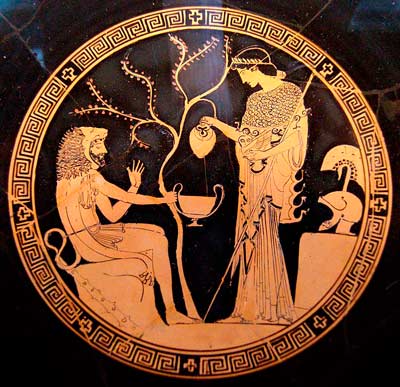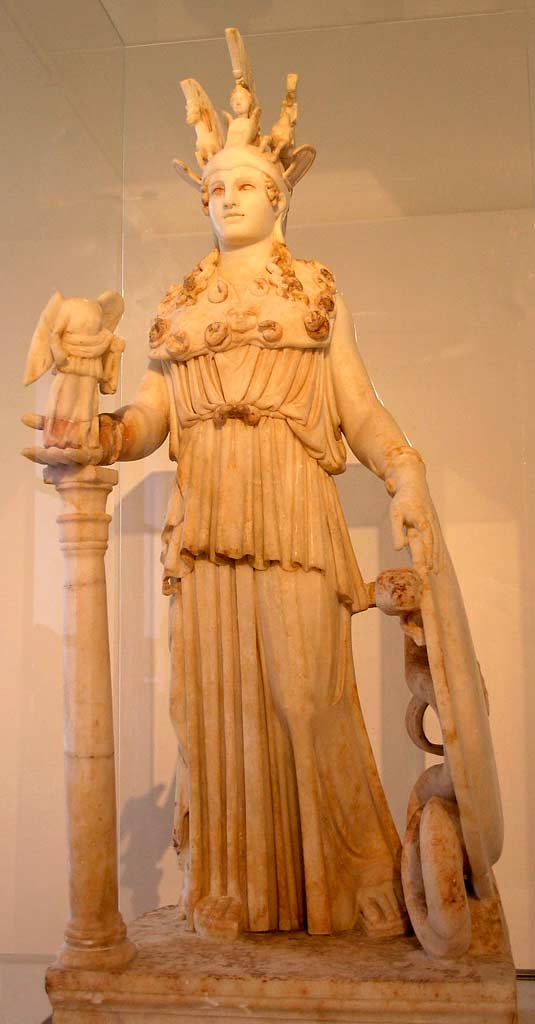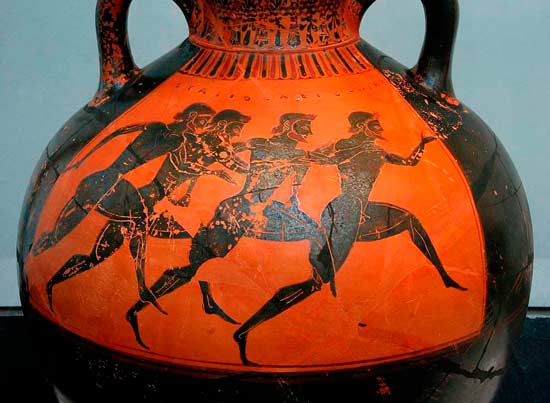Born from the head of Zeus. Zeus knew that the goddess of reason, Metis (Metis), would have two children: a daughter, Athena, and a son of extraordinary intelligence and strength. The goddesses of fate Moira informed Zeus that this son would take away his power over the world. To avoid this, Zeus lulled Metis with affectionate speeches and swallowed her before the birth of children. Soon Zeus felt a terrible pain in his head. To get rid of her, he called on his son Hephaestus and ordered to cut his head. With an ax blow, Hephaestus split the skull of Zeus, and from there, to the amazement of the other Olympian gods, a powerful and beautiful warrior, the goddess Pallas Athena, emerged in full armor. Athena's blue eyes burned with divine wisdom.
Birth of Athena from the head of Zeus. Drawing on an amphora of the second half of the 6th century. BC
Athena - goddess of war
Athena is the “blue-eyed virgin”, the goddess of the clear sky, dispersing the clouds with her sparkling spear, attaching to her shield, Aegis, the snake-haired head of the terrible Gorgon Medusa, the black daughter of the night, at the same time the goddess of victorious energy in any struggle: she is armed with a shield, sword and spear. The goddess Pallas Athena was considered by the Greeks to be the inventor of military art. She is always accompanied by the winged goddess of victory (Nika). Athena - the guardian of cities, the goddess of the acropolises; in honor of her, the goddess of the Athenian Acropolis, the Athenians performed large and small Panathenaic holidays. Being the goddess of war, Athena, however, did not experience joy in battles, like the gods Ares and Eris, but preferred to resolve feuds in peace. In peaceful days, she did not carry weapons, but during wars she received them from Zeus. However, having entered the battle, Pallas never lost it - even to the god of war Ares.
Athena - goddess of wisdom
Pallas Athena keeps order in the weather changes, so that after a thunderstorm that gave rain, the sky clears up again: but she is also the goddess of fertility of fields and gardens; under her patronage, an olive tree grew in Attica, which had such importance for this land; it gives prosperity to the home and family. Under the auspices of Pallas Athena is the civil system, tribal institutions, public life; the goddess of the all-pervading and clear ether, the goddess Athena became in the myths about the gods of Ancient Greece the goddess of the insight of the mind, prudence, the goddess of all inventions of art, the goddess of artistic activity, mental pursuits, the goddess of wisdom. She gives wisdom and knowledge, teaches people the arts and crafts. The girls of ancient Greece honored Pallas Athena as a teacher of home needlework - culinary arts, weaving and spinning. No one can surpass the goddess Athena in the art of weaving. The ancient Greek myth said that it is very dangerous to compete with her in this - Arachne, the daughter of Idmon, who wanted to surpass Athena in this art, severely paid for her arrogance.
The ancient Greeks believed that Pallas Athena, the goddess of wisdom, made a great many useful inventions: she created a flute, a pipe, a ceramic pot, a plow, a rake, a yoke for oxen, bridles for horses, a chariot, a ship, the art of counting. Therefore, the ancient Greek commanders always tried to get useful advice from Athena. Athena Pallas was famous for her kindness, and therefore, when the judges disagreed at the trials in the Areopag of Athens, she always gave her vote for the acquittal of the accused.

The goddess Athena fills Hercules' cup with wine. Ancient Greek vessel ca. 480-470 BC
Little by little, Pallas Athena became the goddess of everything that the Athenians were proud of: the clear sky of Attica, her olive groves, the state institutions of the Athenians, their prudence in war, their courage, their science, poetry, art - everything entered into their idea of \u200b\u200btheir patroness, goddess "Virgin of Athens". The whole life of the Athenians was in close connection with their service to the goddess Pallas Athena, and before they put her statue in the Parthenon temple, they honored her for many centuries in her mythical symbol, the olive tree.
Virginity of Pallas Athena
Virginity was the most characteristic and integral part of the cult of the goddess Athena. According to Greek myths, many gods, titans and giants wanted to enter into marital relations with Pallas, but she rejected all courtship. Once, during the Trojan War, not wanting to ask for weapons from Zeus, who did not support either the Hellenes or the Trojans, Athena asked Hephaestus make her own armor. Hephaestus agreed, but said that he would do the work not for money, but for love. Not understanding the meaning of what was said, Athena came for armor to the forge of Hephaestus. He rushed to the goddess and tried to take possession of her. They say that Hephaestus was incited to this by Poseidon, who lost the dispute to Athena for the possession of Attica: the sea god convinced the Olympic blacksmith of Pallas's secret desire for someone to take possession of her by force. Athena, however, escaped from the hands of Hephaestus, but at the same time his seed spilled on her just above the knee. Pallas wiped herself with a tuft of wool and threw it away. The seed of Hephaestus fell on mother earth Gaia and impregnated her. Dissatisfied with this, Gaia said that she would not raise her unborn child from Hephaestus. Athena then announced that she would raise him herself.

Statue of Athena the Virgin in the Parthenon. Sculptor Phidias
When the child was born, he was named Erichthonius. It was one of the mythical progenitors of the Athenians. Taking Erichtonius from Gaia, Pallas Athena put him in a sacred casket and gave him to Aglavra, the eldest daughter of the Athenian king. Kekropsa. The sad fate of Aglavra, her mother and two sisters is told in myth from Erichthonius. All four died, for Aglavra tried to deceive the god Hermes. Hearing of their sad fate, upset Athena dropped a huge rock that she was carrying to the Athenian Acropolis in order to better strengthen it. This rock was named Mount Lycabettus. The crow, which conveyed to Pallas Athena the mournful news of the death of the women of the Kekrops family, was made black by the goddess from white. Since then, all crows are black. Pallas forbade them to appear on the Athenian acropolis. The goddess Athena Pallas hid Erichtonia in her aegis and raised her. Later he became king of Athens and introduced the cult of his named mother in that city. After his death, Erichthonius was ascended to heaven, becoming the constellation Charioteer, for he, with the help of the goddess Athena, was the first to learn how to use a chariot drawn by four horses.
For the Athenians, the idea of the virginity of their main goddess symbolized the impregnability of their city. Some scholars believe that in ancient myths Pallas Athena was not a virgin, but had children from Hephaestus, Poseidon and the wind god Boreas. Some vague memories of these myths have been preserved in historical Hellas - at least in the above story about Athena and Hephaestus. Erichthonius, most likely, was initially considered the son of Athena and Poseidon. The rest of this myth is preserved in the legend that Erichthonius was the first to ride a quadriga chariot, which in ancient Greek religion was an invariable attribute of Poseidon.
Myths about Pallas Athena
The most famous myths about Athena (except for the above story about Erichthonius) are the legends about the dispute between Athena and Poseidon for the possession of Attica, about the sculptor Pygmalion, about Athena and the satire of Marsyas, about Arachne and of Athena's participation on the side of the Greeks in the Trojan War.
Panathenaia - holidays in honor of Athena
Of the many holidays that ancient Athens celebrated in honor of its patron goddess, and which were mostly agricultural in nature, the most important were the “small Panathenays” and “great Panathenays”. Small were celebrated every year, in the summer; great - once every four years. According to ancient Greek myths, the Panatheneas were founded by the son of Kekrops Erechtheus, a pupil of Athena, the personification of a fertile field.

Competitions of runners during the Panathenaic. Vase ok. 530 BC
The entire population of Attica converged on the great Panathenaia in Athens; a solemn procession carried to the Acropolis a mantle (Peplos), embroidered by the Athenians for the ancient statue of the goddess Pallas Athena, which stood in her Acropolis temple. This mantle was saffron; sewing on it was gold, and represented scenes from the victorious battles of the goddess Athena with the titans. Priests walked ahead with sacrificial animals; the priests were followed by the meteks (foreigners who lived in Athens); they carried sacrificial vessels and other paraphernalia. Girls, daughters of respected families of Athenian citizens, followed the meteks and carried a reaping wreath on their heads, baskets with sacred barley, honey, sacrificial bread; the daughters of the Metecs held umbrellas over them to protect them from the hot summer sun. Further on, a platform set on wheels rode; a mast was approved on it; the peplos of the goddess Pallas Athena was tied to the mast. The musicians followed the platform, followed by young men wearing myrtle wreaths; some walked and sang hymns in honor of the goddess, others were on horseback, armed with a shield and a spear. Further along the streets of Athens came cheerful old men with olive branches in their hands; behind them were the awards intended for the winners of the games: olive wreaths, vessels with olive oil; brought gifts to the temple. Behind them were adult horses and chariots that would compete in running at games in honor of the goddess Athena. At the end of the procession rode on horseback young men belonging to the first two classes of citizens.
